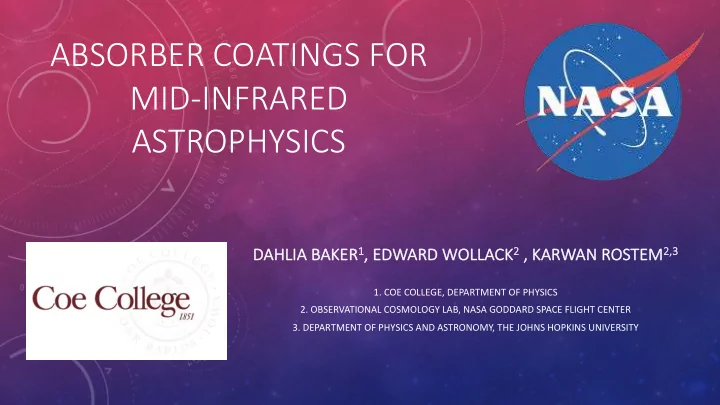

ABSORBER COATINGS FOR MID-INFRARED ASTROPHYSICS ARD WOLLACK 2 , DA DAHLIA BAKER 1 , , EDWAR , KA KARWAN RO ROSTEM 2, 2,3 1. COE COLLEGE, DEPARTMENT OF PHYSICS 2. OBSERVATIONAL COSMOLOGY LAB, NASA GODDARD SPACE FLIGHT CENTER 3. DEPARTMENT OF PHYSICS AND ASTRONOMY, THE JOHNS HOPKINS UNIVERSITY
ABOUT ME • Physics and Mathematic Major • Physics Club and Outreach • Studied Computational Biophysics, moving on to Planetary Science research 2
BACKGROUND HIRMES - High Resolution Mid-InfrarEd Spectrometer • Functioning in the 20-200 micrometer range • Eliminate • SOFIA – Stratospheric Observatory for Infrared Astronomy • 3
APPROACH • Goals • Create a material that absorbs stray light • Lightweight, easy applicable • Known dielectric function • What is this? Describes the electric response to incident radiation Diffusively reflects rather than specularly reflects • Withstand cryogenic temperatures (µK) • • First Step- Characterize the materials • Dielectric functions • Second Step- Matlab Model Model each sample layer with found dielectric function • • Third Step - Manufacturing Create sample plates • 4
Epotech 377H Graphene- Loaded Epoxy APPROACH sC(5):377(65):SiOx(30) 3M Glass Microspheres ~100 microns in diameter Diffuse Specular Aeroglaze Z306 5
SAMPLES Thickness of Epoxy (µm) Sample Letter Final Layer Count Composition (Layer Order) A 579 2 Epoxy, Z306 B 644 3 Epoxy, Z306, K1 C 449 3 Epoxy, K1, Z306 D 505 4 Epoxy, K1, Z306, K1 E 707 1 Epoxy F 494 2 Epoxy, K1 6
DIELECTRIC CHARACTERIZATION Ø Frequency response data taken with a microwave network vector analyzer WR28.0 Sampleholder: K1 Microspheres 0 Transmission through waveguide Average: S11 & S22 Theory: S11, S22 Reflection from sample Average: S12 & S21 -10 Theory: S12, S21 Periodic structure of reflection shows • Response (dB) constructive and destructive interference -20 Shows the “true density” as seen by an • incident electromagnetic wave -30 Loss is due to dielectric properties of • microspheres, scattering due to geometry is not considered -40 22 26 30 34 38 42 7 Frequency (GHz)
THE MODEL Response vs. Wavelength Material Thickness (µm) Dielectric (-) Aluminum 500 1+ 1x10 8 i Epoxy 377H 500 7.4 + 0.4i 3M K1 Microspheres 100 1.1 + 0.002i Aeroglaze Z306 50 2.6 + 0.6i 8
Transmittance vs. Frequency for Epoxy RESULTS • Conclusions Our proposed material can be • manufactured at a small scale Model predicts correct response • Drawback – model cannot predict • response from diffuse scattering due to microspheres Reflectance vs. Frequency for Epoxy • Further Studies Measure optical • frequency-dependent response with a Fourier Transform Spectrometer 9
ACKNOWLEDGEMENTS Coe College Advisors Steve Feller Firdevs Duru Mario Affatigato Ugur Akgun 10
ACKNOWLEDGEMENTS AIP/SPS 11
ACKNOWLEDGEMENTS I would like to give special thanks to the Observational NASA and Collaborators Cosmology Lab at NASA Goddard Space Flight Center and my mentors For their support of my project: Dave Chuss and Riley McCarten, • Villanova University Paul Mirel, Observational Cosmology Lab, • NASA GSFC Edward J. Wollack Kyle Johnson, George Washington University Karwan Rostem • 12
Recommend
More recommend